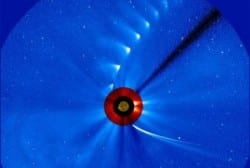Close Encounters With Comet ISON
 It’s not every day that you get to see a comet, but we may soon get the chance to get a glimpse of Comet ISON, which survived its close encounter with the sun last week.
It’s not every day that you get to see a comet, but we may soon get the chance to get a glimpse of Comet ISON, which survived its close encounter with the sun last week.
Jackie Brockington sat down with Dr. Yan Fernandez, director of the Robinson Observatory at the University of Central Florida, to go In Depth on how likely we are to see ISON from Florida.
———————————————
JACKIE BROCKINGTON: Some people are calling this the comet of the century, and it’s paying a visit to our part of the solar system. Tell us about Comet ISON. Why is this one so particularly interesting?
YAN R. FERNANDEZ: This one is very interesting, because it is on its first trip from the outer parts of the solar system to the inner part of the solar system in about 4.5 billion years. So, it’s been in the deep freeze for a very long time. That means it is — we hope — a pristine record of what the conditions were like 4.5 billion years ago, when the solar system was actually forming, because the comet is a remnant of this era.
JB: On Thanksgiving it was close to the sun. Did the comet survive the sun’s heat?
FERNANDEZ: It’s possible that some of it survived. We are not 100 percent sure yet, but indeed it seemed that the thermal stress from passing so close to the sun was too much for some of the comet. A lot of it turned into little, tiny dust grains, and there’s not much of a body left. We’re not sure how much is left. We’re pretty sure there’s a little bit left, and in the pictures that we’ve been seeing, the comet was fading, looking like it didn’t really survive.
JB: This comet was supposed to become visible to people across America. Will we still get to see it, and if so, what’s the best time to look for it?
FERNANDEZ: It’s possible that there’s still something to see. There’s still a cloud of dust from the comet that will be in the sky. The question is: How bright is it going to be? It most certainly won’t be as bright as we’d hoped it would be.
The best way to still see it in Central Florida is if you go well away from Orlando and well into the country, very far from light pollution. You have to be in a very dark area. For example, if you were in a forest, way down in Avon Park or down in Kissimmee Prairie, some places that are well away from the city, where there’s almost no light pollution at all, then you’ll probably be able to see it. That’s probably going to be your best chance.
JB: Do you need a telescope to see it?
FERNANDEZ: It might be possible to see it with a telescope. It’s going to be very diffused, so there’s going to be a little bit of a challenge. The problem is that it’s still fairly close to the sun, so you’ll be looking for it in twilight, or in the morning before dawn. And with the sky brightness being what it is, it might be hard to pick out a diffused cloud of dust in the sky unless you know exactly where to look.
JB: I remember when we had the story about a little boy who found some pieces of what was determined to be some type of comet. Do you know what it came from? Might that have been some part of it?
FERNANDEZ: If that really did happen and it came from space, it’s probably not from Comet ISON, because Comet ISON wasn’t coming anywhere near Earth. It was tens of millions of miles away from Earth, and it’s going to be tens of millions of miles away after. So, it’s unlikely. It probably is some other object.
JB: That’s pretty exciting, that we might possibly have the ability to see something from so many years ago and learn from it. I would imagine what it was like all those years ago.
FERNANDEZ: That’s a really fundamental question in astronomy. How did we get here? How did planet Earth come to be the way it is? Comets are going to help us.
To read the original article, click here.
